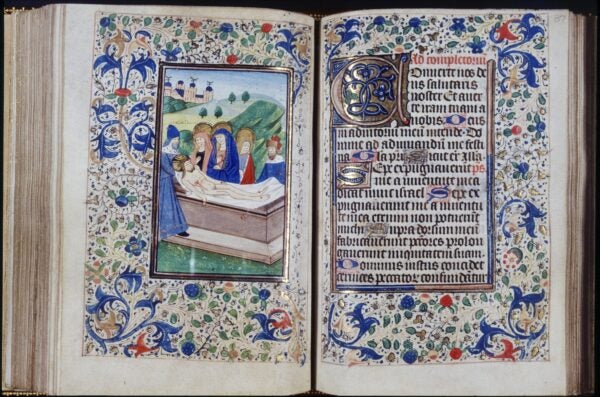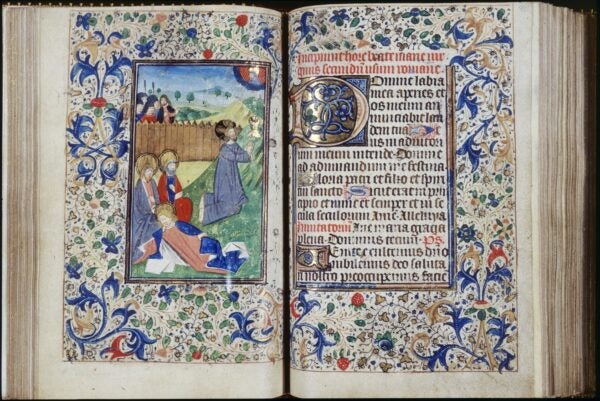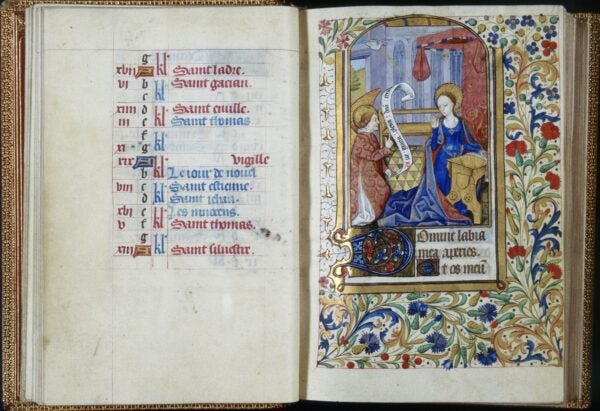Books of hours: illuminating the Trinity College Watkinson Library special collections

Attributed to Studio of unknown French (illuminator), Possibly Style of unknown Flemish (illuminator). c.1470 (creation date). Book of Hours (Horae Beatae Mariae Virginis in Usum Ecclesiae Romanae cum Calendario), Folio 86v: Hours of the Virgin: Compline: Entombment, overall, left, with Folio 87r at right. Illumination, Leaf (component), Manuscript. Place: Trinity College, Watkinson Library (Hartford, Connecticut, USA).
Books of hours are devotional texts that contain a personalized selection of prayers, hymns, psalms, and New Testament excerpts chosen specifically for their owner. Popular in the Middle Ages, the most expensive of these books could be highly decorated, but the more affordable versions usually only showed minimal decoration, usually of the first letter of a page. They had, in fact, become so popular by the 16th century that they were often owned by people from all walks of society; servants even had their own copies—there is a court case from 1500 where a pauper woman was accused of stealing a servant’s book of hours.
- Attributed to unknown French (illuminator). c.1470 (creation date). Book of Hours (Horae Beatae Mariae Virginis), Folio 13r: Hours of the Virgin: Matins: Annunciation, overall, right, shown with folio 12v at left. Illumination, Leaf (component), Manuscript. Place: Trinity College, Watkinson Library (Hartford, Connecticut, USA).
- Attributed to Master of Jean Rolin II (illuminator, French, act. ca.1440-1465). c.1460 (creation date). Book of Hours (Horae Beatae Mariae Virginis), Folio 59r: Hours of the Virgin: Prime: Nativity, overall. Illumination, Leaf (component), Manuscript. Place: Trinity College, Watkinson Library (Hartford, Connecticut, USA).
The books were often personalized by including texts of particular interest to the owner—most of whom were women—and with the addition of their name in certain prayers. The books were meant to help the owners structure their daily lives and prayer schedules around the eight canonical hours—to help those leading secular lives to take the time to be more monastic in their daily devotions.
Many books were richly illuminated with religious iconography, calendar cycles, zodiac symbols, pastoral scenes and, in some highly decorated ones, the owners themselves depicted in the scenes as religious figures. Because books of hours were popular, they also provide an important record of life and medieval iconography.

Attributed to Studio of unknown French (illuminator), Possibly Style of unknown Flemish (illuminator). c.1470 (creation date). Book of Hours (Horae Beatae Mariae Virginis in Usum Ecclesiae Romanae cum Calendario), Folio 39v: Hours of the Virgin: Matins: Agony in the Garden, overall, left, with Folio 40r at right.. Illumination, Leaf (component), Manuscript. Place: Trinity College, Watkinson Library (Hartford, Connecticut, USA).
The include many images of books of hours from the middle ages that are freely available for everyone to view and download, no login necessary. (Hint: filter your search results to Manuscripts and Manuscript Illuminations to see just these books.)

